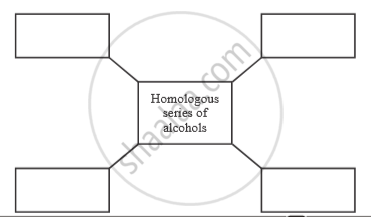Advertisements
Advertisements
Question
Succeeding members of a homologous series differ by ______.
Options
\[\ce{CH}\]
\[\ce{CH2}\]
\[\ce{CH3}\]
Solution
Succeeding members of a homologous series differ by CH2.
Explanation:
In a homologous series, each successive member differs from the previous one by a \[\ce{CH2}\] (methylene) group. This consistent difference maintains similar chemical properties while increasing molecular mass in a predictable pattern.
APPEARS IN
RELATED QUESTIONS
Write the molecular formula of first two members of homologous series having functional group −Br.
The following vegetables are kept in a basket :
Potato, Tomato, Radish, Brinjal, Carrot, Bottle-gourd
Which two of these vegetables correctly represent the homologous structures?
(A) Carrot and Tomato
(B) Potato and Brinjal
(C) Radish and Carrot
(D) Radish and Bottle-gourd
By how many carbon atoms and hydrogen atoms do any two adjacent homologues differ?
Define a homologous series. Give the name and structural formula of one homologue of the following:
CH3OH
Give the dot diagram of the first member of the alcohol.
Write names of first four homologous series of alcohols.

As one ascends in any homologous series, physical properties change gradually.
Complete the following table for the homologous series of alkanes.
| Name | Molecular formula | Condensed structural formula | Number of carbon atom | Number of -CH2- units | Boiling point °C |
| Methane | CH4 | CH4 | 1 | 1 | -162 |
| Ethane | C2H6 | CH3–CH3 | 2 | 2 | -88.5 |
| Propane | C3H8 | CH3–CH2–CH3 | 3 | 3 | -42 |
| Butane | C4H10 | CH3–CH2–CH2–CH3 | ______ | ______ | 0 |
| Pentane | C5H12 | CH3–CH2–CH2–CH2–CH3 | ______ | ______ | 36 |
| Hexane | C6H14 | CH3–CH2–CH2–CH2–CH2–CH3 | ______ | ______ | 69 |
Complete the following table for homologous series of Alkenes.
| Name | Molecular formula | Condensed structural formula | Number of carbon atom | Number of -CH2- units | Boiling point °C |
| Ethene | C2H4 | CH2 = CH2 | 2 | 0 | -102 |
| Propene | C3H6 | CH3–CH = CH2 | 3 | 1 | -48 |
| 1-Butene | C4H8 | CH3–CH2–CH = CH2 | ______ | ______ | -6.5 |
| 1-Pentene | C5H10 | CH3–CH2–CH2–CH = CH2 | ______ | ______ | 30 |
Name the following:
Group of organic compounds where the successive members follow a regular structural pattern, successive compounds differ by a 'CH2' group.
